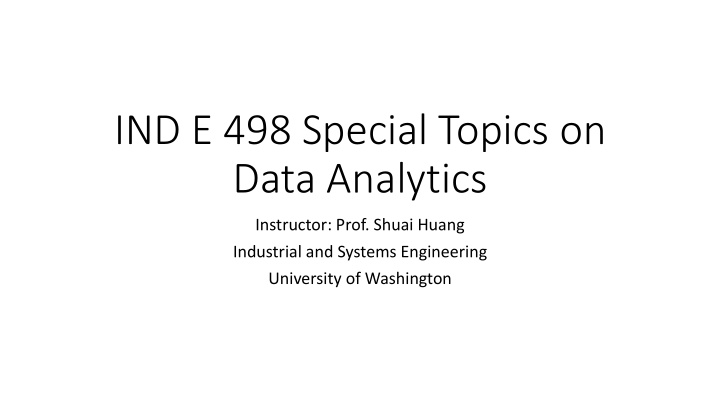



IND E 498 Special Topics on Data Analytics Instructor: Prof. Shuai Huang Industrial and Systems Engineering University of Washington
Overview of the course • Course website (http://analytics.shuaihuang.info/) • Syllabus • Study group • Data sources/R/stackoverflow/github • Project meetings
A typical data analytics pipeline
The two cultures of statistical modeling ? 𝑧 = 𝑔 𝒚 + 𝜗 𝑔 𝑦 𝜗 “Cosmology” Statistical Imply Cause and Explicit form (e.g., 𝑔 𝑦 = 𝛾 0 + 𝛾 1 𝑦 Data Modeling distribution (e.g., effect; articulate linear regression) Gaussian) uncertainty Rarely modeled as Look for accurate structured surrogate for Algorithmic Implicit form (e.g., uncertainty; only prediction; to fit the Modeling tree model) acknowledged as data rather than to meaningless noise explain the data
Key topics in regression models • Chapter 2: Linear regression, least-square estimation, hypothesis testing, why normal distribution, its connection with experimental design, R-squared. • Chapter 3: Logistic regression, generalized least square estimation, iterative reweighted least square (IRLS) algorithm, approximated hypothesis testing, Ranking as a linear regression • Chapter 4: Bootstrap, data resampling, nonparametric hypothesis testing, nonparametric confidence interval • Chapter 5: Overfitting and underfitting, limitation of R-squared, training dataset and testing dataset, random sampling, K-fold cross validation, the confusion matrix, false positive and false negative, and Receiver Operating Characteristics (ROC) curve • Chapter 6: Residual analysis, normal Q- Q plot, Cook’s distance, leverage, multicollinearity, subset selection, heterogeneity, clustering, gaussian mixture model (GMM), and the Expectation-Maximization (EM) algorithm • Chapter 7: Support Vector Machine (SVM), generalize data versus memorize data, maximum margin, support vectors, model complexity and regularization, primal-dual formulation, quadratic programming, KKT condition, kernel trick, kernel machines, SVM as a neural network model • Chapter 8: LASSO, sparse learning, L1-norm and L2-norm regularization, Ridge regression, feature selection, shooting algorithm, Principal Component Analysis (PCA), eigenvalue decomposition, scree plot • Chapter 9: Kernel regression as generalization of linear regression model, kernel functions, local smoother regression model, k-nearest regression model, conditional variance regression model, heteroscedasticity, weighted least square estimation, model extension and stacking
Key topics in tree models • Chapter 2: Decision tree, entropy gain, node splitting, pre- and post-pruning, empirical error, generalization error, pessimistic error by binomial approximation, greedy recursive splitting • Chapter 4: Random forest, Gini index, weak classifiers, probabilistic mechanism why random forest works • Chapter 5: Out-of-bag (OOB) error in random forest • Chapter 6: Importance score, partial dependency plot, residual analysis • Chapter 7: Ensemble learning, Adaboost, sampling with (or without) replacement • Chapter 8: Importance score in random forest, regularized random forests (RRF), guided regularized random forests (GRRF) • Chapter 9: System monitoring reformulated as classification, real-time contrasts method (RTC), design of monitoring statistics, sliding window, anomaly detection, false alarm • Chapter 10: Integration of tree models, feature selection, and regression models in inTrees, random forest as a rule generator, rule extraction, pruning, selection, and summarization, confidence and support of rules, variable interactions, rule-based prediction
Key concepts – significance versus truth • Statistical modeling is to pursue statistical significance • In other words, it may not be true, but it is significant
Key concepts – The rhetoric of “what if” • “Luckily, the data is not contradictory with our hypothesis/theory” • You will rarely hear statisticians say that, “luckily, we accept the null hypothesis” Hypothesis testing: Pr(data | Null hypothesis is true) Truth seeking: Pr(Null hypothesis is true | data) This mentality, the “negative” reading of data, is one foundation of classic statistics
Key concepts – Training/testing data • Instead of establishing the significance of the model by hypothesis testing, modern machine learning models establish the significance of the model by, roughly speaking, the paradigm of “training/testing data”
Key concepts – feature
A side story about features
Another story about features …
Key concepts – overfitting/generalization
Key concepts – context Why 60% accuracy is still very valuable ❖ Anti-amyloid clinical trials need large- scale screening: $3,000 per PET scan ❖ If the PET scan shows negative result, $3,000 is a waste ❖ Blood measurements cost $200 per visit ❖ Question: can we use blood measurements to predict the amyloid? ❖ Benefit: enrich the cohort pool with more amyloid positive cases
Key concepts – insight The story of the statistician Abraham Wald in World War II ▪ The Allied AF lost many aircrafts, so they decided to armor their aircrafts up ▪ However, limited resources are available – which parts of the aircrafts should be armored up? ▪ Abraham Wald stayed in the runaway, to catalog the bullet holes on the returning aircrafts
Recommend
More recommend